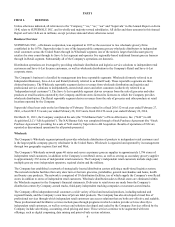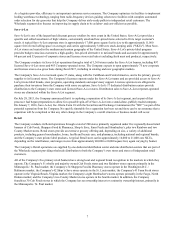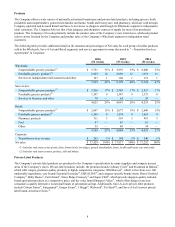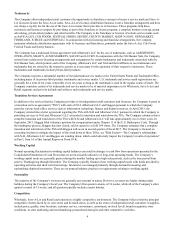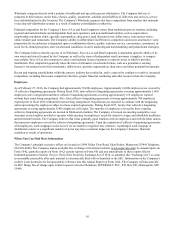Albertsons 2016 Annual Report Download - page 18
Download and view the complete annual report
Please find page 18 of the 2016 Albertsons annual report below. You can navigate through the pages in the report by either clicking on the pages listed below, or by using the keyword search tool below to find specific information within the annual report.
16
and withdrawals of other companies from these plans, have caused most multiemployer pension plans in which the Company
participates to be underfunded. Many of these plans have required rehabilitation plans or funding improvement plans, and the
Company can give no assurances of the extent to which a rehabilitation plan or a funding improvement plan will improve the
funded status of the plan. The Company expects that the unfunded liabilities of these plans will result in increased future
payments by the Company and the other participating employers over the next few years. Underfunded multiemployer pension
plans may, in certain situations, impose a surcharge requiring additional pension contributions. The Company’s risk of such
increased payments may be greater if any of the participating employers in these underfunded plans withdraws from the plan
due to insolvency and is not able to contribute an amount sufficient to fund the unfunded liabilities associated with its
participants in the plan. A significant increase to funding requirements could adversely affect the Company’s financial
condition, results of operations or cash flows.
The financial condition of these pension plans may also negatively impact the Company’s debt ratings, which may increase the
cost of borrowing, adversely affect the Company’s ability to access one or more financial markets or result in a default under
the Company’s debt instruments.
As of February 27, 2016, the Company is a party to 55 collective bargaining agreements covering approximately 16,000 of its
employees, of which 24 collective bargaining agreements covering approximately 8,400 employees are scheduled to expire in
fiscal 2017. In addition, during fiscal 2016, nine collective bargaining agreements covering approximately 1,600 employees
were renegotiated. In fiscal 2016, three collective bargaining agreements covering approximately 110 employees expired
without their terms being renegotiated. Also four collective bargaining agreements covering approximately 700 employees
expired prior to fiscal 2016 without terms being negotiated. Negotiations are expected to continue with the bargaining units
representing the employees subject to those agreements. In future negotiations with labor unions, the Company expects that,
among other issues, rising healthcare, pension and employee benefit and wage costs and operational flexibility will be
important topics for negotiation. There can be no assurance that the Company will be able to negotiate the terms of expiring or
expired agreements in a manner acceptable to the Company. Therefore, potential increases in operating costs or work
disruptions from labor disputes could disrupt the Company’s businesses and adversely affect the Company’s financial condition
and results of operations. Certain of the Company’s operations have employees who are non-union, and while the Company
believes its employee relations are strong, there can be no assurance that these operations will not experience pressure from
labor unions or become the target of campaigns to unionize.
The Company’s relationships with NAI, Albertson’s LLC and Haggen are winding down, which could adversely impact
the Company’s results of operations.
In connection with the sale of NAI in March 2013, the Company entered into the TSA with each of NAI and Albertson’s LLC
to support the divested NAI banners and the continuing operations of Albertson’s LLC. The Company continues to perform
services under the TSA with each of NAI and Albertson’s LLC, and the Company is also providing services as needed to
transition and wind down these TSA. The Company estimates that the complete transition and wind down of the TSA could
take approximately two to three more years. This estimate is based on the transition completed to date and information
currently known to the Company and could change.
The transition and wind down of the TSA could be time consuming and resource intensive for the Company. The Company is
working with NAI and Albertson’s LLC to coordinate the requirements to fully transition and wind down the TSA. While the
transition and wind down has proceeded smoothly to date, this work is on-going and could lead to disputes with NAI and
Albertson’s LLC, including related to what services the Company must perform to transition and wind down these TSA, the
manner or timeline in which these transition and wind down services are performed and the cost to perform these services,
which could cause disruptions and adversely impact the Company’s results of operations.
The amount of revenue the Company receives under the TSA with each of NAI and Albertson’s LLC is based on the number of
NAI and Albertson’s LLC stores and distribution centers receiving services under the TSA. Pursuant to the terms of the TSA,
NAI and Albertson’s have notified the Company, and will continue to notify the Company during the transition and wind down
of the TSA, that NAI and Albertson's LLC have decided to not receive further services at stores or distribution centers. As
stores and distributions centers are removed from the TSA, the variable fee the Company receives under the TSA is reduced
beginning shortly after the Company receives notice of such removal and the store or distribution center is no longer receiving
services. The fixed portion of the TSA fee for stores and distribution centers also resets each September 22 (beginning
September 22, 2015) based on the number of stores and distribution centers receiving services as of such date.
The Company entered into the Haggen TSA in December 2014 to provide services to 164 stores and also entered into a supply
agreement with Haggen to supply certain of the stores in two states. In September 2015, Haggen filed voluntary petitions for
reorganization under Chapter 11 of the U.S. Bankruptcy Code. Through the bankruptcy process, Haggen has now closed, sold


